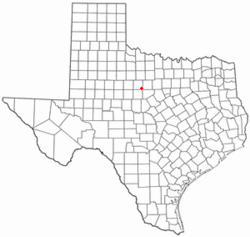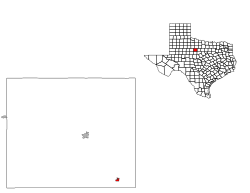Moran, Texas facts for kids
Quick facts for kids
Moran, Texas
|
|
|---|---|

Location of Moran, Texas
|
|
 |
|
| Country | United States |
| State | Texas |
| County | Shackelford |
| Area | |
| • Total | 0.42 sq mi (1.10 km2) |
| • Land | 0.42 sq mi (1.10 km2) |
| • Water | 0.00 sq mi (0.00 km2) |
| Elevation | 1,365 ft (416 m) |
| Population
(2020)
|
|
| • Total | 226 |
| • Density | 538/sq mi (205.5/km2) |
| Time zone | UTC-6 (Central (CST)) |
| • Summer (DST) | UTC-5 (CDT) |
| ZIP code |
76464
|
| Area code(s) | 325 |
| FIPS code | 48-49320 |
| GNIS feature ID | 2411158 |
Moran is a small city in Shackelford County, Texas, in the United States. In 2020, about 226 people lived there.
Contents
Where is Moran, Texas?
Moran is located where two roads meet: Texas State Highway 6 and Farm to Market Road 576. A "Farm to Market Road" is a state highway that connects rural areas to towns.
The city is about 15 miles southeast of Albany. It is also 18 miles northwest of Cisco. Other nearby cities include Breckenridge and Abilene.
Several creeks flow near Moran. These include Deep Creek, Post Oak Creek, Battle Creek, and Hubbard Creek.
The United States Census Bureau says that Moran covers about 0.4 square miles (1.1 square kilometers). All of this area is land.
How Did Moran Get Started?
People first settled in this area around the 1860s. During the American Civil War (1861–1865), they built a temporary fort. It was called Mugginsville and was located on Deep Creek. A famous cattle trail, the Western Cattle Trail, also passed nearby.
More people moved to the area after the Texas Central Railroad arrived in 1881. The town was first called Hulltown. It was started by Mary and George Washington "Swope" Hull in 1883. They opened a general store near the railroad crossing. George Hull was also the first postmaster. He bought 160 acres of land and planned out the town in 1884.
The town's name changed to Hicks in 1890. Then, in 1892, it changed one last time to Moran. This new name honored Charles Moran, who owned the Texas Central Railroad.
Moran's Growth and Changes
By 1900, Moran had several businesses and a school. It also had different churches, like Baptist and Methodist. A local newspaper started in 1895, and a bank opened in 1902.
In 1910, something big happened. The Cottle No. 1 natural gas well was discovered nearby. This was the first commercial gas well in this part of West Texas. In 1911, gas was piped into Moran for homes and businesses.
Within two years, in 1913, other cities like Albany and Abilene also started getting natural gas from the Moran Field. By October 1913, the Moran Field was known as a very important source of natural gas in Texas.
For the next 15 years, finding more oil and gas made Moran a "boom town." This means its population grew very quickly. At one point in the 1920s, between 5,000 and 10,000 people lived there. But by the 1930s, the boom ended. The population slowly went down to what it is today.
Many of these facts come from historical markers in the town.
Recent History and Economy
In the late 1980s, Moran became famous for hosting the National Fajita Cook-off. This event brought many visitors from around the world.
In the 2000s, a company called Slide Fire Solutions moved to Moran. This company made special gun parts.
Today, Moran's economy still depends on farming and ranching. Oil and gas production also remains important for the area.
Local historical markers tell more about Moran's past. They include markers for the town itself, the Cottle No. 1 Natural Gas Well, and the Moran Cemetery.
Who Lives in Moran?
| Historical population | |||
|---|---|---|---|
| Census | Pop. | %± | |
| 1920 | 1,055 | — | |
| 1930 | 907 | −14.0% | |
| 1940 | 710 | −21.7% | |
| 1950 | 610 | −14.1% | |
| 1960 | 392 | −35.7% | |
| 1970 | 335 | −14.5% | |
| 1980 | 344 | 2.7% | |
| 1990 | 285 | −17.2% | |
| 2000 | 233 | −18.2% | |
| 2010 | 270 | 15.9% | |
| 2020 | 226 | −16.3% | |
| U.S. Decennial Census | |||
Population in 2020
| Race | Number | Percentage |
|---|---|---|
| White (NH) | 206 | 91.15% |
| Mixed/Multi-Racial (NH) | 4 | 1.77% |
| Hispanic or Latino | 16 | 7.08% |
| Total | 226 |
The 2020 United States census counted 226 people living in Moran. There were 96 households and 72 families in the city.
Education in Moran
The Moran Independent School District serves the city of Moran. The school's mascot is a bulldog. The school colors are purple and gold.
Moran Historical Museum
The Moran Historical Museum opened in 1979. It was started by the Moran Historical Society. The museum has many items that show the town's history. You can find it in the old Moran Church of Christ building, near the City Park.
See also
 In Spanish: Moran (Texas) para niños
In Spanish: Moran (Texas) para niños

